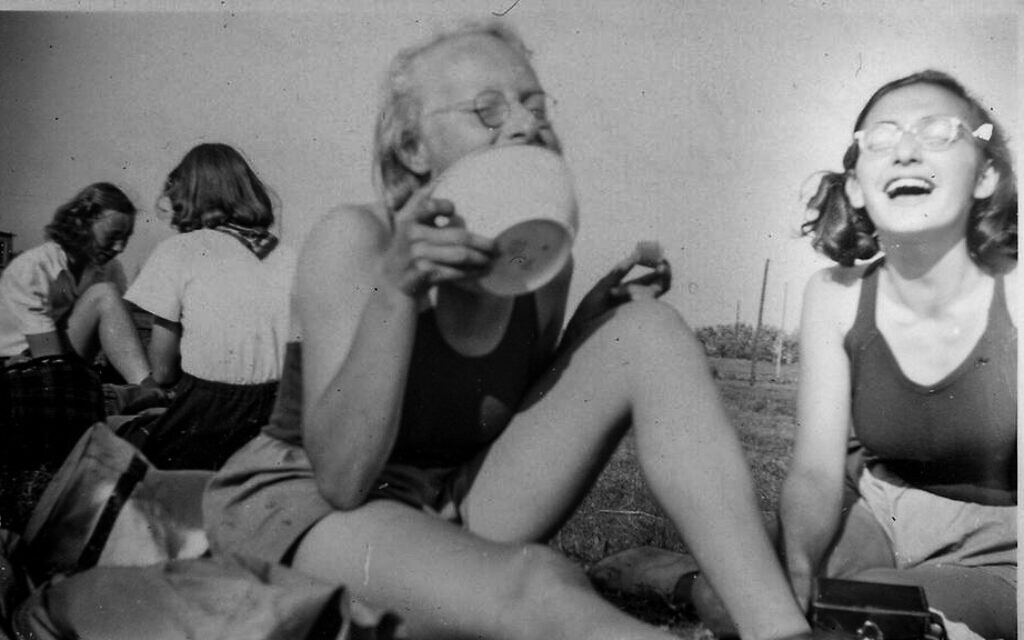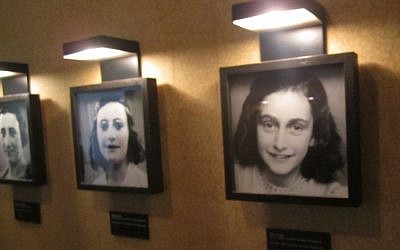No wallflower: Margot Frank comes out of her sister’s shadow in new photos
Besides being her younger sister Anne’s well-behaved foil, Margot was academically and athletically gifted — and she too kept a diary

Although Margot Frank kept a diary while in hiding, only her sister’s writings survived the war. Since then, Anne Frank’s older sister has had a low-key legacy, usually depicted as Anne’s reserved, better-behaved foil on stage and screen.
With the release of two new photos by the Anne Frank House this week, a side of Margot rarely seen took center stage: that of an athlete heartily laughing with her Dutch teammates during practice.
Taken during the summer of 1941, the photos show Margot with her rowing team on the Amstel River, from which Amsterdam derives its name. In one photo she is featured prominently, while the other is a wide-shot of the team in two boats.
The new photos of Margot were donated to the museum by Paul Mensinga, the nephew of Margot’s rowing coach who captured the images.
Margot was a member of the “Society for the Promotion of Water Sports Among Young People,” and her club, near the Berlage Bridge, was a short bicycle ride from the Frank family apartment in the River Quarter. The girls attended different schools in the same neighborhood, with the family deciding Anne was a fit for the Montessori system.
“Margot was a beautiful, bright, and sporty girl,” said Teresien da Silva, head of collections at the Anne Frank House. The museum released the photos to mark the 94th birthday of Margot on February 16.
“We already had some pictures of Margot on skis, on ice skates, and on the tennis court, and now we also have photos of Margot with her rowing club,” said da Silva. “These new photos show a cheerful girl, enjoying herself with her crew mates.”
In the photos of Margot with her teammates, she is not the wallflower depicted in adaptations of Anne’s diary. Her head is not stuck in a book, nor is she helping with chores. Instead, this Margot is a cheerful, outgoing young woman, enjoying time on the river with friends despite the intensification of anti-Jewish laws.

The photos were taken by Margot’s gym and rowing coach, Roos van Gelder. The team included Jewish and non-Jewish girls until Jews were banned from water sports in the fall. Because she too was Jewish, van Gelder could no longer coach sports, and the non-Jewish team members “showed solidarity” by quitting, according to the museum.
For more than two years, Margot Frank, Anne and six others hid in the back-house of father Otto Frank’s office building. Of the whole group, only Otto came back from the Nazi camps to which the group was sent following their discovery and arrest in 1944.
In 1960, the Anne Frank House museum opened in the former hiding place and adjacent buildings.
‘Margot doesn’t need raising’
Whether on stage, screen, or graphic novels, Margot Frank remains in the background of her sister’s story. Perhaps, had Margot’s diary also been rescued, the two Frank sisters would be equally famous.
Although Margot’s diary has been lost to history, we have a sense of her writing style and inner struggles from letters she wrote to her younger sister.
During the spring of 1944, Anne and Peter van Pels started to take more than a passing interest in each other. In addition to this burgeoning relationship causing tension between Anne and her parents, there was also an exchange of letters between Anne and Margot about what Anne feared could become a love triangle.

“Anne, yesterday when I said I wasn’t jealous of you, I wasn’t being entirely honest,” wrote Margot in a letter to Anne on March 20.
“The situation is this: I’m not jealous of either you or Peter,” wrote Margot. “I’m just sorry I haven’t found anyone with whom to share my thoughts and feelings, and I’m not likely to in the near future. But that’s why I wish, from the bottom of my heart, that you will both be able to place your trust in each other. You’re already missing out on so much here, things other people take for granted.”
In her reply to Margot, Anne expressed relief that Margot did not feel slighted. She also explained that her relations with Peter were not as advanced — or “trusting” — as it appeared.
Picking up the exchange, Margot expanded her assessment of Peter in the next letter. In addition to viewing Peter as “a kind of younger brother,” Margot found that he didn’t make the grade when it came to her ideals.

“I’d want to have the feeling that [a boyfriend] understood me through and through, even if I didn’t say much,” said Margot. “For this reason it would have to be someone I felt was intellectually superior to me and that isn’t the case with Peter. But I can imagine your feeling close to him.”
When Margot wrote these words to Anne, the sisters had less than one year to live. In August, the Nazis raided the office building and hiding place, capturing the eight “fugitive” Jews. They also arrested two of the Dutch office workers who helped sustain the group in hiding with food, medicine, and constant protection.
After being imprisoned at the Dutch transit camp Westerbork and Auschwitz-Birkenau, the Frank sisters were transferred to Bergen-Belsen in Germany. Although not a death camp, conditions at Bergen-Belsen were horrendous. Starved, exhausted, and afflicted with spotted typhus, Margot and Anne Frank were among thousands of prisoners who died in the weeks leading up to the camp’s liberation in April 1945.

Are you relying on The Times of Israel for accurate and timely coverage right now? If so, please join The Times of Israel Community. For as little as $6/month, you will:
- Support our independent journalists who are working around the clock;
- Read ToI with a clear, ads-free experience on our site, apps and emails; and
- Gain access to exclusive content shared only with the ToI Community, including exclusive webinars with our reporters and weekly letters from founding editor David Horovitz.

We’re really pleased that you’ve read X Times of Israel articles in the past month.
That’s why we started the Times of Israel eleven years ago - to provide discerning readers like you with must-read coverage of Israel and the Jewish world.
So now we have a request. Unlike other news outlets, we haven’t put up a paywall. But as the journalism we do is costly, we invite readers for whom The Times of Israel has become important to help support our work by joining The Times of Israel Community.
For as little as $6 a month you can help support our quality journalism while enjoying The Times of Israel AD-FREE, as well as accessing exclusive content available only to Times of Israel Community members.
Thank you,
David Horovitz, Founding Editor of The Times of Israel









